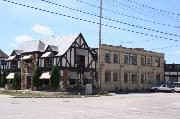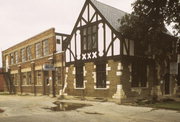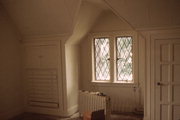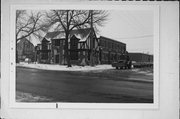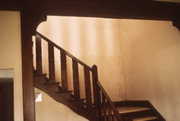Property Record
214 WASHINGTON ST
Architecture and History Inventory
| Historic Name: | Northwest Electrolyte and Engraving Office and Plant |
|---|---|
| Other Name: | Northwest Electrotype and Engraving Offices |
| Contributing: | Yes |
| Reference Number: | 61288 |
| Location (Address): | 214 WASHINGTON ST |
|---|---|
| County: | Winnebago |
| City: | Menasha |
| Township/Village: | |
| Unincorporated Community: | |
| Town: | |
| Range: | |
| Direction: | |
| Section: | |
| Quarter Section: | |
| Quarter/Quarter Section: |
| Year Built: | 1930 |
|---|---|
| Additions: | |
| Survey Date: | 2009 |
| Historic Use: | retail building |
| Architectural Style: | English Revival Styles |
| Structural System: | |
| Wall Material: | Asbestos |
| Architect: | Henry Auler |
| Other Buildings On Site: | |
| Demolished?: | No |
| Demolished Date: |
| National/State Register Listing Name: | Washington Street Historic District |
|---|---|
| National Register Listing Date: | 5/30/1986 |
| State Register Listing Date: | 1/1/1989 |
| National Register Multiple Property Name: |
| Additional Information: | Leaded windows, half timbering.In 1928 the Menasha Wooden Ware Company hired Oshkosh architect Henry Auler to design a business district in the "English style of architecture." The district was to be located along Washington Street on part of the company's Doty Island stave yards, which were no longer in use after a production conversion from wooden tubs to corrugated paper shipping products. The plans were announced after the construction of the Washington Street Bridge and just prior to the construction of the Tayco Street Bridge, both of which were expected to spawn a commercial resurgence and expansion of the western section of the central business district. The completion of the latter project would unify the width of Tayco Street to that of Washington Street, allowing this corridor to better serve as part of U.S. Highway 41. The Auler plans called for a theater, garage, and various store buildings, three of which are known to have been constructed: the Inter City Oil Company Filling Station (demolished), the Verbrick Gas Station (216 Washington Street), and the Northwest Electrotype and Engraving Offices and Plant (214 Washington Street). The rest of the district was never completed, perhaps due to the construction of the Brin Building (1 Main Street), which included the stores and theater called for in the Menasha Wooden Ware plan. The balance of the Doty Island stave yards was purchased by Marathon Corporation for a plant built in 1947. C.G. Renner formed Northwest Electrotype Company in 1925, with it sfirst offices in Neenah. In 1931 the Offices and Plant were constructed on Washington Street, followed by the formation of the Northwest Engraving Company in the 1930's. Establishment of the latter business appears to have corresponded with a second floor addition to the plant in 1935. Each business occupied one floor of the structure until 1951, when the building was sold to Marathon Corporation. The Northwest Electrotype and Engraving Offices and Plant is of local historical significance for its association with the expansion of the central business district. The Northwest Electrotype and Engraving Offices and Plant is lcoated on the Menasha side of Doty Island on the principal corridor of travel between Menasha and Neenah. Situated on the southwest corner of Washington and Garfield Streets, the two story building has a rectangular building plan and a roof that is both gabled and flat. The offices are Tudor Revival Period design, while the attached plant is industrial vernacular. The slate shingled roof is gabled with two gabled dormers. The walls are red brick with an American bond on the first floor, foliated half timbering with stucco infill on the second. The foundations aer concrete. The windows are mullioned casements, while the fenestration is formally balanced around a hipped pavillion of brick. The pavillion serves as the principa entrance and includes a stone entryway with dripstop and Tudor arch. Other features include a beamed jetty, and random stone around windows and corners where the walls are surfaced in brick. The interior on the first floor emains largely unaltered, with sutcco walls, beams, and dark woodwork in two offices nad a central hall. On the second floor some remodelling has taken place so that the two offices open directly into the plant. A closet and built in chest of drawers are the only noteworthy feature of the original second floor offices. The plant is attached directly behind the offices. The roof is flat, the walls are red brick with an American bond, and the foundations are concrete. The fenestration is regular and rhythmic with multi paned metal sash, except on the west facade where service entrance and a second floor fire escape. Decorative featues include applied buttresses and concrete sill and lintel courses. The Northwest Electrotype and Engraving Offices and Plant is a contributing member of the Washington Street Historic District. The Offices are of architectural significance as a fine example of Tudor Period design as applied to commercial use. It is one of four commercial buildings of Period design in Menasha and is one of two with Tudor references. The other commercial examples are the United Staets Post Office (84 Racine Street), Verbrick's Gas Station (216 Washington street), and the Brin Building (1 Main Steret). Each are fine examples of Colonial, Tudor, and Mediterranean Period designs, respectively. Verbrick's Gas Station, the only other example of Tudor Period commercial architecture, is adjacent to the Offices and can be differentiated by its barn or carriage house references. Tudor Period residences can also be found on Lake Road and Nicolet Boulevard, but these are less distinguished than the Offices, which apply foliated half timbering and other fine details to a utilitarian structure. 2009--No apparent changes have been made to the structure since it was last surveyed in 1984. |
|---|---|
| Bibliographic References: | A. Menasha Record; May 24, 1928; page 1. iB. Ibid.; April 23, 1928; page 1. C. Shattuck, S.F. History of Neenah. Privately printed, 1958. Neenah, Wisconsin. Page 332. D. Interview with Jack Renner, August 1985. E. 1931 Tax Roll, City of Menasha; page 47l; 1935 Tax Roll, City of Menasha, page 45. F. Johnson's 1952 Neenah Menasha Directory, page 573. G. Neenah Daily News Times; December, 1930. |
| Wisconsin Architecture and History Inventory, State Historic Preservation Office, Wisconsin Historical Society, Madison, Wisconsin |

